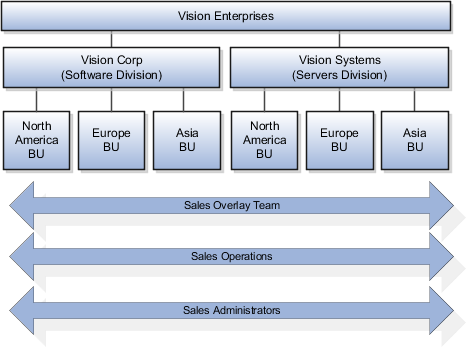What should I know about sales resources and multiple business units?
When your sales users work in business objects like opportunities and leads – and you're operating in a multiple-business-unit environment – the users' access to the data is based on their involvement in business artifacts.
Sales User Access to Transactional Data
Users get access to transactional data by:
- Inclusion in the Sales resource hierarchy
- Membership in a territory or sales team
- Being granted full access to the object
Thus, users can have access to data across many business units by their involvement in artifacts. Or, they could have access only to data in a single business unit (BU). It all depends on their membership. For example, a salesperson can have access to data via team and territory membership, irrespective of the BUs they're associated with in the resource hierarchy.
Business unit assignment can indirectly affect a user's access to object transactional data. In a multiple BU environment, BUs are available as territory dimensions and can be included as part of the territory coverage definition for the assignment of transactions. A sales user gains access to object data through territory membership. If BU is specified as a territory dimension, then the user's access to data is limited to objects which, when they were created, were assigned to the same BU that's assigned to the user's territory team.
Sales Administrator Access to Business Units
Sales administrators, who are created as resources in the organization, have access to all the data available in the BUs to which they're associated.
Use Case With Resources Across Business Units
Sometimes, you might want to have certain types of users have visibility into data across BUs. For example, you might want your overlay salespeople to have access to all BUs. Here are some examples:
- Associate overlay salespeople with all business units and differentiate them using territory dimensions, such as geographic region of responsibility.
- Associate sales operations and sales administrators to one, many, or all business units.
In the use case presented here, Vision Enterprises is a global high-technology company with two divisions: Vision Corp., focused on software, and Vision Systems, selling high-end servers and engineered systems that combine hardware and software in a single stack. Both divisions operate globally across North America, Europe, and Asia Pacific regions, so they create BUs for each of these areas.

Resource Organizations with Multiple Business Units
By associating resource organizations with business units, you can control access to the transactional data available to sales resources in business objects like opportunities and leads.
Here's how to associate resource organizations with multiple business units:
-
In Setup and Maintenance go to:
-
Offering: Sales
-
Functional Area: Users and Security
-
Task: Manage Resource Organization Members
-
-
In the Manage Resource Organization Members page, search for and select the resource organization that you want to associate with a business unit.
-
In the Organization page, click the Business Units tab.
-
In the table, click the add row icon.
-
Select a business unit from the Business Unit list.
-
Click Save. The first business unit you selected is set as the primary business unit.
-
Similarly, select more business units from the Business Unit drop-down list.
-
Click Save and Close.